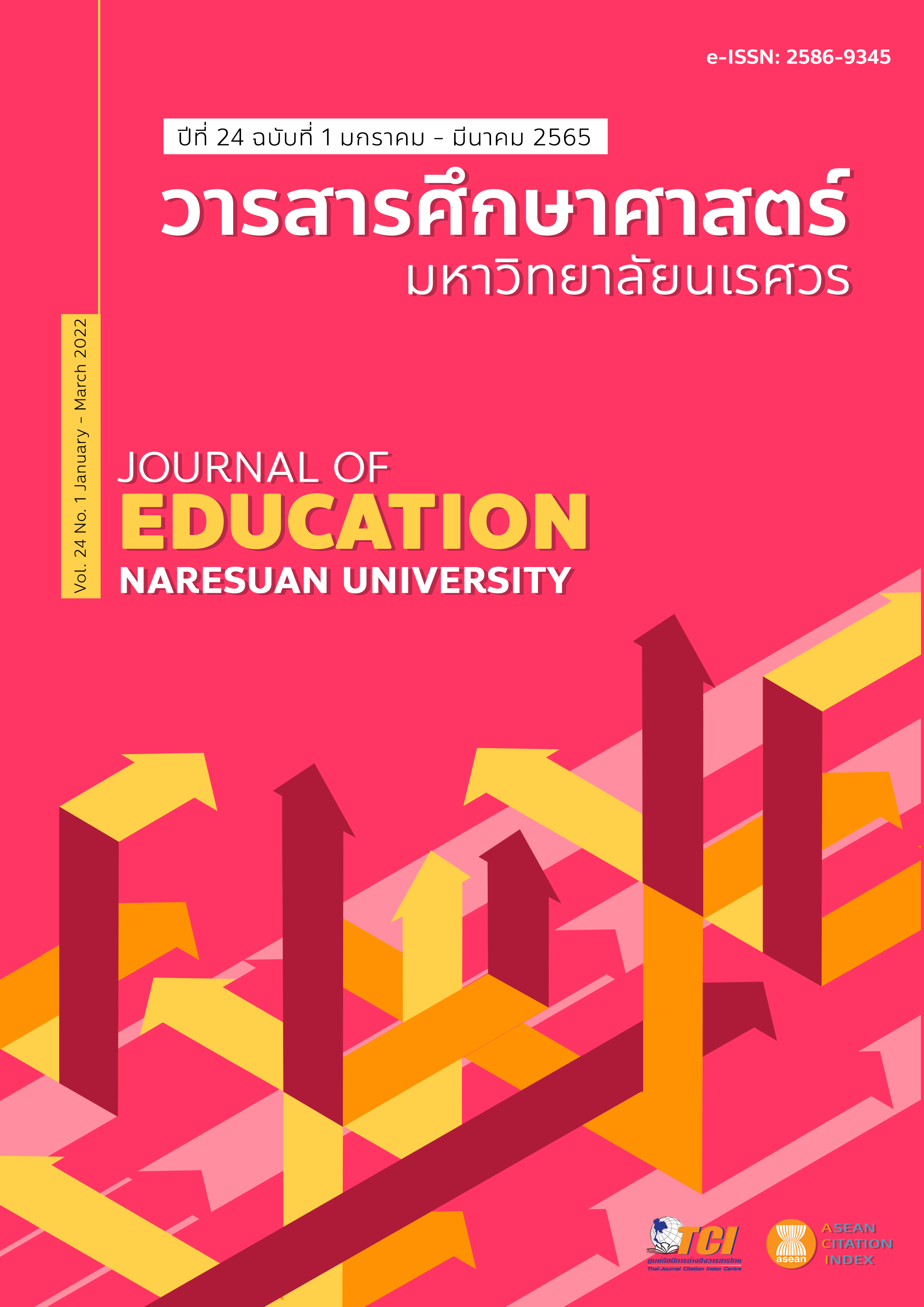STEM EDUCATION BASED ON ENGINEERING DESIGN PROCESS FOR DEVELOPING GRADE 10 STUDENTS’ COLLABORATIVE PROBLEM SOLVING COMPETENCIES IN MOTIONS TOPIC การจัดการเรียนรู้ตามแนวสะเต็มศึกษาที่เน้นกระบวนการออกแบบเชิงวิศวกรรมเพื่อส่งเสริมสมรรถนะการแก้ปัญหาแบบร่วมมือ เรื่อง การเคลื่อนที่แบบต่างๆ ของนักเรียนชั้นมัธยมศึกษาปีที่ 4
Main Article Content
Abstract
The purposes of this research were to study the effective ways of using engineering design process based on STEM education and to promote collaborative problem solving competencies in motions topic for 10th grade students. The participants were 45 10th grade students. The research instruments included lesson plans,
the collaborative problem solving competency observation form, the collaborative problem-solving competency test, and the learning management observation. Data were analyzed through content analysis and the method of triangulation was employed to ensure the creditability of this research. The research results indicated that the effective ways to develop students’ collaborative problem solving competency comprised of 1) defining the interesting problem related to everyday life, 2) defining challenging workloads to the class including an experiment to solve the problem, work piece construction, and 3) testing the results, and encouraging students to reflect and evaluate their ideas with argumentation. Most of the students had high and medium levels of proficiency in collaborative problem solving competency in all three competencies. However, when considered the performance of students, the best competency of students was establishing and maintaining team organization, establishing and maintaining shared understanding, and Taking appropriate action to solve the problem, respectively.
Article Details

This work is licensed under a Creative Commons Attribution-NonCommercial-NoDerivatives 4.0 International License.
The owner of the article does not copy or violate any of its copyright. If any copyright infringement occurs or prosecution, in any case, the Editorial Board is not involved in all the rights to the owner of the article to be performed.
References
Antonenko, P. D., Jahanzad, F., & Greenwood, C. (2014). Fostering collaborative problem solving and 21st century skills using the DEEPER scaffolding framework. Journal of College Science, 43(6), 78-87.
Asghar, M. Y., Viitanen, T., Kemppainen, K., & Tornquist, K. (2012). Sphingosine 1- phosphate and human ether-a'-go-go-related gene potassium channels modulate migration in human anaplastic thyroid cancer cells. Endocrine - Related Cancer, 19(5), 667-680. https://doi.org/10.1530/ERC-12-0092
Bitter, C. G. (1990). Mathematics method for the elementary and middle school: A comprehensive approach. Boston: Allyn and Bacon.
Bureau of Academic Affairs and Educational Standards [BAAES]. (2015). Collaborative problem solving. Retrieved January 25, 2020, from https://drive.google.com/folderview?id=0BwnYgcDtSNqaQkU3VzVEdXdqNG8&usp=sharing&tid=0BwnYgcDtSNqaTTIwS1ZhdHVXMzg. [in Thai]
Householder, D. L., & Hailey, C. E. (2012). Incorporating engineering design challenges into STEM courses. Retrieved November 10, 2019, from https://digitalcommons.usu.edu/ncete_publications/166
Institute for the Promotion of Teaching Science and Technology (IPST). (2014). Activity Manual for Level4 (M.4-M.6), Bangkok: Institute for the Promotion of Teaching Science and Technology (IPST), Ministry of Education. [in Thai]
Institute for the Promotion of Teaching Science and Technology (IPST). (2018). PISA 2015 Assessment of Reading Science and Mathematics Excellence and educational equality. Bangkok: Success Public Company Limited. [in Thai]
Joyce, B., & Weil, M. (1996). Model of teaching (5th ed.). Boston: Allyn and Bacon.
Kemmis, S., McTaggart, R., & Nixon, R. (2014). The action research planner: Doing critical participatory action research. New York: Springer.
McNaught, C. (2014). Implementing research based education at UCL. Retrieved May 2, 2020, from http://www.ucl.ac.uk/teaching-learning/connectedcurriculum/research-based-education
Organization for Economic Co-operation and Development (OECD). (2015). PISA 2015 draft collaborative problem solving framework. Paris: OECD.
Nualpong, W. (2010). Development of learning activity management based on CIPPA model in the invention of Thai wisdom topic of artificial intelligence subject for grade 12 students (Independent Study). Mahasarakham: Mahasarakham University. [in Thai]
Susan, H., & Marci, D. (2011). NASA’s best students beginning engineering science, and technology. Retrieved August 1, 2019, from https://www.nasa.gov/audience/foreducators/best/edp.html
Suthee, S., Wanpakae, P., & Saengtopho, S. (2001). Techniques for developing an integrated curriculum. Bangkok: Development Education. [in Thai]
The Secretariat of the Council of Education. (2018). Thai Education Report 2018 (Education in Thailand 2018). Bangkok: The Secretariat of the Education Council Ministry of Education. [in Thai]


